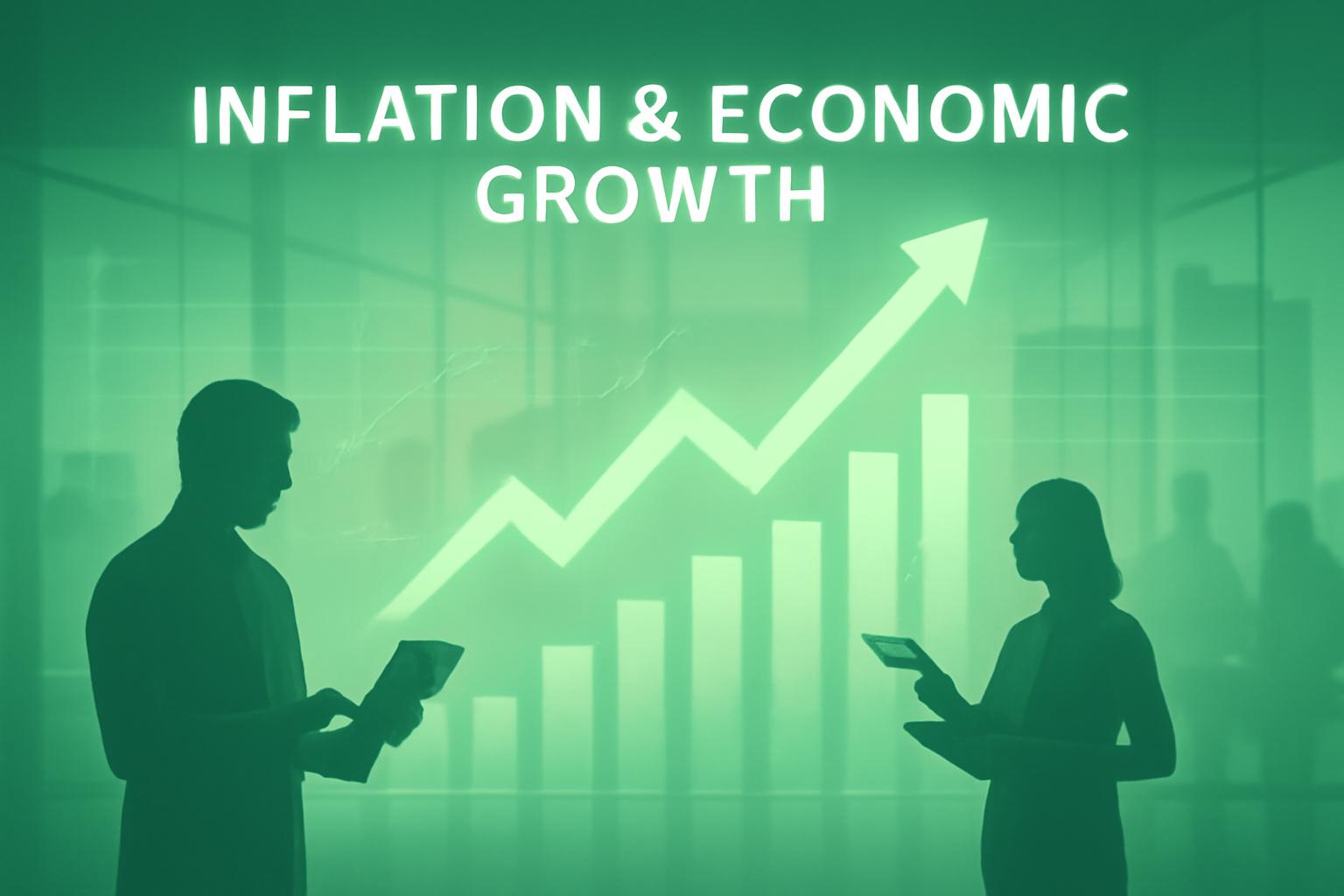August’s inflation and economic data reinforce the Federal Reserve’s path toward measured interest rate reductions. Core inflation stability combined with robust consumer income and spending suggests the economy is weathering tariff pressures better than anticipated. !-- wp:paragraph -->
- Opportunities: Continued consumer resilience may support steady economic growth and allow for gradual monetary easing.
- Risks: Persistent inflation above the Fed’s 2% target could limit the scope and pace of future rate cuts.
- Market Impact: Positive investor sentiment driven by steady inflation and clear Fed guidance.
- Policy Outlook: Two additional quarter-point rate cuts are likely, but cautious Fed messaging tempers expectations for aggressive easing.
FinOracleAI — Market View
August’s inflation and economic data reinforce the Federal Reserve’s path toward measured interest rate reductions. Core inflation stability combined with robust consumer income and spending suggests the economy is weathering tariff pressures better than anticipated. !-- wp:paragraph -->- Opportunities: Continued consumer resilience may support steady economic growth and allow for gradual monetary easing.
- Risks: Persistent inflation above the Fed’s 2% target could limit the scope and pace of future rate cuts.
- Market Impact: Positive investor sentiment driven by steady inflation and clear Fed guidance.
- Policy Outlook: Two additional quarter-point rate cuts are likely, but cautious Fed messaging tempers expectations for aggressive easing.
FinOracleAI — Market View
August’s inflation and economic data reinforce the Federal Reserve’s path toward measured interest rate reductions. Core inflation stability combined with robust consumer income and spending suggests the economy is weathering tariff pressures better than anticipated. !-- wp:paragraph -->- Opportunities: Continued consumer resilience may support steady economic growth and allow for gradual monetary easing.
- Risks: Persistent inflation above the Fed’s 2% target could limit the scope and pace of future rate cuts.
- Market Impact: Positive investor sentiment driven by steady inflation and clear Fed guidance.
- Policy Outlook: Two additional quarter-point rate cuts are likely, but cautious Fed messaging tempers expectations for aggressive easing.
FinOracleAI — Market View
August’s inflation and economic data reinforce the Federal Reserve’s path toward measured interest rate reductions. Core inflation stability combined with robust consumer income and spending suggests the economy is weathering tariff pressures better than anticipated. !-- wp:paragraph -->- Opportunities: Continued consumer resilience may support steady economic growth and allow for gradual monetary easing.
- Risks: Persistent inflation above the Fed’s 2% target could limit the scope and pace of future rate cuts.
- Market Impact: Positive investor sentiment driven by steady inflation and clear Fed guidance.
- Policy Outlook: Two additional quarter-point rate cuts are likely, but cautious Fed messaging tempers expectations for aggressive easing.
Federal Reserve’s Policy Path Remains Unchanged
The Federal Reserve continues to target a 2% inflation rate but is unlikely to alter its current course based on the August data. Officials anticipate two additional quarter-point rate cuts before year-end, following the first 25 basis point reduction in months approved last week, which set the benchmark range at 4.00%-4.25%. !-- wp:paragraph --> Fed Chair Jerome Powell and other policymakers view tariffs as a transient factor rather than a driver of sustained inflation. However, some remain cautious, noting limited room for further cuts amid persistent inflation above target. !-- wp:paragraph --> Market reactions to the data were positive: stock futures advanced while Treasury yields declined slightly, reflecting investor confidence in the Fed’s gradual easing strategy. !-- wp:paragraph -->FinOracleAI — Market View
August’s inflation and economic data reinforce the Federal Reserve’s path toward measured interest rate reductions. Core inflation stability combined with robust consumer income and spending suggests the economy is weathering tariff pressures better than anticipated. !-- wp:paragraph -->- Opportunities: Continued consumer resilience may support steady economic growth and allow for gradual monetary easing.
- Risks: Persistent inflation above the Fed’s 2% target could limit the scope and pace of future rate cuts.
- Market Impact: Positive investor sentiment driven by steady inflation and clear Fed guidance.
- Policy Outlook: Two additional quarter-point rate cuts are likely, but cautious Fed messaging tempers expectations for aggressive easing.
- Goods prices edged up 0.1% in August.
- Services prices increased by 0.3%.
- Food prices rose by 0.5%.
- Energy costs jumped 0.8%.
- Housing expenses grew 0.4%.
Federal Reserve’s Policy Path Remains Unchanged
The Federal Reserve continues to target a 2% inflation rate but is unlikely to alter its current course based on the August data. Officials anticipate two additional quarter-point rate cuts before year-end, following the first 25 basis point reduction in months approved last week, which set the benchmark range at 4.00%-4.25%. !-- wp:paragraph --> Fed Chair Jerome Powell and other policymakers view tariffs as a transient factor rather than a driver of sustained inflation. However, some remain cautious, noting limited room for further cuts amid persistent inflation above target. !-- wp:paragraph --> Market reactions to the data were positive: stock futures advanced while Treasury yields declined slightly, reflecting investor confidence in the Fed’s gradual easing strategy. !-- wp:paragraph -->FinOracleAI — Market View
August’s inflation and economic data reinforce the Federal Reserve’s path toward measured interest rate reductions. Core inflation stability combined with robust consumer income and spending suggests the economy is weathering tariff pressures better than anticipated. !-- wp:paragraph -->- Opportunities: Continued consumer resilience may support steady economic growth and allow for gradual monetary easing.
- Risks: Persistent inflation above the Fed’s 2% target could limit the scope and pace of future rate cuts.
- Market Impact: Positive investor sentiment driven by steady inflation and clear Fed guidance.
- Policy Outlook: Two additional quarter-point rate cuts are likely, but cautious Fed messaging tempers expectations for aggressive easing.
“Net, net, consumers literally hit it out of the park with very strong gains in spending not just for August, but June and July as well,” said Chris Rupkey, chief economist at Fwdbonds. “Summer was the time for consumer revenge spending after hunkering down during the uncertainty and fear produced by the White House tariff rollout in April and May.”
Limited Inflation Impact from Tariffs
Despite concerns that President Donald Trump’s tariffs would drive consumer prices higher, the latest report indicates only a modest pass-through effect. Companies have mitigated cost pressures through pre-tariff inventory stockpiling and absorbing expenses, limiting inflationary impact. !-- wp:paragraph -->- Goods prices edged up 0.1% in August.
- Services prices increased by 0.3%.
- Food prices rose by 0.5%.
- Energy costs jumped 0.8%.
- Housing expenses grew 0.4%.
Federal Reserve’s Policy Path Remains Unchanged
The Federal Reserve continues to target a 2% inflation rate but is unlikely to alter its current course based on the August data. Officials anticipate two additional quarter-point rate cuts before year-end, following the first 25 basis point reduction in months approved last week, which set the benchmark range at 4.00%-4.25%. !-- wp:paragraph --> Fed Chair Jerome Powell and other policymakers view tariffs as a transient factor rather than a driver of sustained inflation. However, some remain cautious, noting limited room for further cuts amid persistent inflation above target. !-- wp:paragraph --> Market reactions to the data were positive: stock futures advanced while Treasury yields declined slightly, reflecting investor confidence in the Fed’s gradual easing strategy. !-- wp:paragraph -->FinOracleAI — Market View
August’s inflation and economic data reinforce the Federal Reserve’s path toward measured interest rate reductions. Core inflation stability combined with robust consumer income and spending suggests the economy is weathering tariff pressures better than anticipated. !-- wp:paragraph -->- Opportunities: Continued consumer resilience may support steady economic growth and allow for gradual monetary easing.
- Risks: Persistent inflation above the Fed’s 2% target could limit the scope and pace of future rate cuts.
- Market Impact: Positive investor sentiment driven by steady inflation and clear Fed guidance.
- Policy Outlook: Two additional quarter-point rate cuts are likely, but cautious Fed messaging tempers expectations for aggressive easing.
Personal Income and Spending Show Unexpected Strength
Data revealed that personal income rose by 0.4% in August, outpacing estimates by 0.1 percentage points. Concurrently, personal consumption expenditures accelerated by 0.6%, also above forecasts. This resilience in consumer finances suggests sustained economic momentum despite tariff-related uncertainties. !-- wp:paragraph -->“Net, net, consumers literally hit it out of the park with very strong gains in spending not just for August, but June and July as well,” said Chris Rupkey, chief economist at Fwdbonds. “Summer was the time for consumer revenge spending after hunkering down during the uncertainty and fear produced by the White House tariff rollout in April and May.”
Limited Inflation Impact from Tariffs
Despite concerns that President Donald Trump’s tariffs would drive consumer prices higher, the latest report indicates only a modest pass-through effect. Companies have mitigated cost pressures through pre-tariff inventory stockpiling and absorbing expenses, limiting inflationary impact. !-- wp:paragraph -->- Goods prices edged up 0.1% in August.
- Services prices increased by 0.3%.
- Food prices rose by 0.5%.
- Energy costs jumped 0.8%.
- Housing expenses grew 0.4%.
Federal Reserve’s Policy Path Remains Unchanged
The Federal Reserve continues to target a 2% inflation rate but is unlikely to alter its current course based on the August data. Officials anticipate two additional quarter-point rate cuts before year-end, following the first 25 basis point reduction in months approved last week, which set the benchmark range at 4.00%-4.25%. !-- wp:paragraph --> Fed Chair Jerome Powell and other policymakers view tariffs as a transient factor rather than a driver of sustained inflation. However, some remain cautious, noting limited room for further cuts amid persistent inflation above target. !-- wp:paragraph --> Market reactions to the data were positive: stock futures advanced while Treasury yields declined slightly, reflecting investor confidence in the Fed’s gradual easing strategy. !-- wp:paragraph -->FinOracleAI — Market View
August’s inflation and economic data reinforce the Federal Reserve’s path toward measured interest rate reductions. Core inflation stability combined with robust consumer income and spending suggests the economy is weathering tariff pressures better than anticipated. !-- wp:paragraph -->- Opportunities: Continued consumer resilience may support steady economic growth and allow for gradual monetary easing.
- Risks: Persistent inflation above the Fed’s 2% target could limit the scope and pace of future rate cuts.
- Market Impact: Positive investor sentiment driven by steady inflation and clear Fed guidance.
- Policy Outlook: Two additional quarter-point rate cuts are likely, but cautious Fed messaging tempers expectations for aggressive easing.
Personal Income and Spending Show Unexpected Strength
Data revealed that personal income rose by 0.4% in August, outpacing estimates by 0.1 percentage points. Concurrently, personal consumption expenditures accelerated by 0.6%, also above forecasts. This resilience in consumer finances suggests sustained economic momentum despite tariff-related uncertainties. !-- wp:paragraph -->“Net, net, consumers literally hit it out of the park with very strong gains in spending not just for August, but June and July as well,” said Chris Rupkey, chief economist at Fwdbonds. “Summer was the time for consumer revenge spending after hunkering down during the uncertainty and fear produced by the White House tariff rollout in April and May.”
Limited Inflation Impact from Tariffs
Despite concerns that President Donald Trump’s tariffs would drive consumer prices higher, the latest report indicates only a modest pass-through effect. Companies have mitigated cost pressures through pre-tariff inventory stockpiling and absorbing expenses, limiting inflationary impact. !-- wp:paragraph -->- Goods prices edged up 0.1% in August.
- Services prices increased by 0.3%.
- Food prices rose by 0.5%.
- Energy costs jumped 0.8%.
- Housing expenses grew 0.4%.
Federal Reserve’s Policy Path Remains Unchanged
The Federal Reserve continues to target a 2% inflation rate but is unlikely to alter its current course based on the August data. Officials anticipate two additional quarter-point rate cuts before year-end, following the first 25 basis point reduction in months approved last week, which set the benchmark range at 4.00%-4.25%. !-- wp:paragraph --> Fed Chair Jerome Powell and other policymakers view tariffs as a transient factor rather than a driver of sustained inflation. However, some remain cautious, noting limited room for further cuts amid persistent inflation above target. !-- wp:paragraph --> Market reactions to the data were positive: stock futures advanced while Treasury yields declined slightly, reflecting investor confidence in the Fed’s gradual easing strategy. !-- wp:paragraph -->FinOracleAI — Market View
August’s inflation and economic data reinforce the Federal Reserve’s path toward measured interest rate reductions. Core inflation stability combined with robust consumer income and spending suggests the economy is weathering tariff pressures better than anticipated. !-- wp:paragraph -->- Opportunities: Continued consumer resilience may support steady economic growth and allow for gradual monetary easing.
- Risks: Persistent inflation above the Fed’s 2% target could limit the scope and pace of future rate cuts.
- Market Impact: Positive investor sentiment driven by steady inflation and clear Fed guidance.
- Policy Outlook: Two additional quarter-point rate cuts are likely, but cautious Fed messaging tempers expectations for aggressive easing.
Core Inflation Remains Stable at 2.9% in August
August’s personal consumption expenditures (PCE) price index, the Federal Reserve’s preferred inflation gauge, showed core inflation steady at 2.9% year-over-year, in line with market expectations. The Commerce Department reported a monthly increase of 0.2% in core PCE prices, excluding volatile food and energy categories. !-- wp:paragraph --> The headline PCE inflation rate, which includes all items, rose 0.3% for the month, bringing the annual rate to 2.7%, a slight uptick from July’s 2.6%. These figures matched the consensus forecast from Dow Jones, signaling inflation pressures remain contained. !-- wp:paragraph -->Personal Income and Spending Show Unexpected Strength
Data revealed that personal income rose by 0.4% in August, outpacing estimates by 0.1 percentage points. Concurrently, personal consumption expenditures accelerated by 0.6%, also above forecasts. This resilience in consumer finances suggests sustained economic momentum despite tariff-related uncertainties. !-- wp:paragraph -->“Net, net, consumers literally hit it out of the park with very strong gains in spending not just for August, but June and July as well,” said Chris Rupkey, chief economist at Fwdbonds. “Summer was the time for consumer revenge spending after hunkering down during the uncertainty and fear produced by the White House tariff rollout in April and May.”
Limited Inflation Impact from Tariffs
Despite concerns that President Donald Trump’s tariffs would drive consumer prices higher, the latest report indicates only a modest pass-through effect. Companies have mitigated cost pressures through pre-tariff inventory stockpiling and absorbing expenses, limiting inflationary impact. !-- wp:paragraph -->- Goods prices edged up 0.1% in August.
- Services prices increased by 0.3%.
- Food prices rose by 0.5%.
- Energy costs jumped 0.8%.
- Housing expenses grew 0.4%.
Federal Reserve’s Policy Path Remains Unchanged
The Federal Reserve continues to target a 2% inflation rate but is unlikely to alter its current course based on the August data. Officials anticipate two additional quarter-point rate cuts before year-end, following the first 25 basis point reduction in months approved last week, which set the benchmark range at 4.00%-4.25%. !-- wp:paragraph --> Fed Chair Jerome Powell and other policymakers view tariffs as a transient factor rather than a driver of sustained inflation. However, some remain cautious, noting limited room for further cuts amid persistent inflation above target. !-- wp:paragraph --> Market reactions to the data were positive: stock futures advanced while Treasury yields declined slightly, reflecting investor confidence in the Fed’s gradual easing strategy. !-- wp:paragraph -->FinOracleAI — Market View
August’s inflation and economic data reinforce the Federal Reserve’s path toward measured interest rate reductions. Core inflation stability combined with robust consumer income and spending suggests the economy is weathering tariff pressures better than anticipated. !-- wp:paragraph -->- Opportunities: Continued consumer resilience may support steady economic growth and allow for gradual monetary easing.
- Risks: Persistent inflation above the Fed’s 2% target could limit the scope and pace of future rate cuts.
- Market Impact: Positive investor sentiment driven by steady inflation and clear Fed guidance.
- Policy Outlook: Two additional quarter-point rate cuts are likely, but cautious Fed messaging tempers expectations for aggressive easing.













